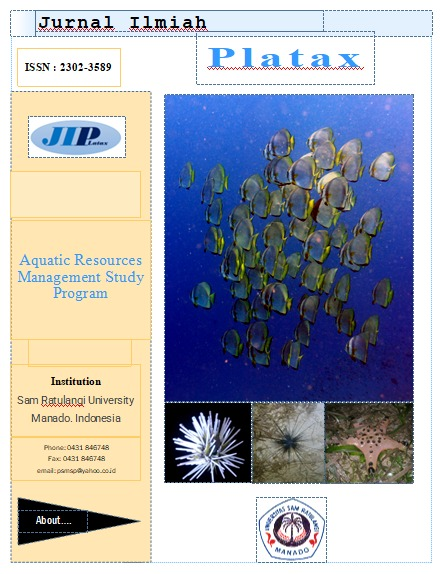The Effectiveness of Cylindrical Attractors Against Squid Egg Attachment in Manado Bay Waters
DOI:
https://doi.org/10.35800/jip.v11i1.45858Keywords:
Attractor;, Squid eggs;, Manado Bay;Abstract
Data collection in this study used a descriptive method, namely collecting, describing, and describing events systematically and accurately in accordance with the objects observed. This method aims to provide a systematic, factual, and accurate picture of the facts, nature, and relationships between phenomena, test hypotheses, make predictions and get the meaning and implications of the problems investigated. It can be seen that the attachment of squid eggs in the second location has not been observed during observations from August 2022 to September 2022. Observations at the East Malalayang One location did not find any laying of eggs, due to cloudy water conditions, while the two West One Malalayang locations found sticking of eggs with a total of 241 eggs attached, the number of attachments to the iron type attractor was 202 squid eggs and to the drum type namely 39 squid eggs. Squid attractors in the form of iron are mostly attached to eggs where the effectiveness rate is between 83.8% while for the type of used drum attractor, it is only around 16.2%. The form of the iron attractor is more effective because the iron attractor's cover is covered with parent nets. It can also be seen that the effectiveness of attaching squid eggs according to the level of water depth, for the effectiveness of squid sticking at a depth of 3 meters (53.53%) compared to only 5 meters (46.47%).
Keywords: Attractor, Squid eggs, Manado Bay
Abstrak
Pengambilan data dalam penelitian ini menggunakan metode deskriptif yaitu mengumpulkan, menguraikan, dan menggambarkan peristiwa secara sistematis dan akurat sesuai dengan objek yang diamati. Tujuan penggunaan metode ini yaitu untuk memberikan gambaran secara sistematis, faktual dan akurat tentang fakta, sifat, serta hubungan antara fenomena, menguji hipotesa, membuat prediksi dan mendapatkan makna serta implikasi dari masalah yang diselidiki. Pengamatan di lokasi Malalayang Satu Timur tidak ditemukan penempelan telur, dikarenakan kondisi perairan yang keruh, sedangkan lokasi dua Malalayang Satu Barat ditemukan penempelan telur dengan jumlah penempelan 241 telur, jumlah penempelan pada atraktor tipe besi yakni 202 telur cumi dan pada tipe drum yakni 39 telur cumi. Atraktor cumi berbentuk besi lebih banyak di tempeli dengan telur dimana tingkat efektifitasnya antara 83,8% sedangkan untuk tipe atraktor drum bekas hanya sekitar 16,2%. Bentuk atraktor besi lebih efektif karena bagian penutup atraktor besi semuanya ditutupi jaring paranet. Terlihat juga efektivitas penempelan telur cumi menurut tingkat kedalaman perairan, untuk efektivitas cumi yang menempel pada kedalaman 3 meter yakni (53,53%) dibandingkan 5 meter hanya (46,47%).
Atraktor; Telur cumi-cumi; Teluk Manado
Downloads
Published
How to Cite
Issue
Section
License
Copyright (c) 2023 Irawan Angge, Wilhemina Patty; Fransisco P.T. Pangalila

This work is licensed under a Creative Commons Attribution-NonCommercial 4.0 International License.
COPYRIGHT
Authors who publish with this journal agree to the following terms:
Authors hold their copyright and grant this journal the privilege of first publication, with the work simultaneously licensed under a Creative Commons Attribution License that permits others to impart the work with an acknowledgment of the work's origin and initial publication by this journal.
Authors can enter into separate or additional contractual arrangements for the non-exclusive distribution of the journal's published version of the work (for example, post it to an institutional repository or publish it in a book), with an acknowledgment of its underlying publication in this journal.
Authors are permitted and encouraged to post their work online (for example, in institutional repositories or on their website) as it can lead to productive exchanges, as well as earlier and greater citation of the published work (See The Effect of Open Access).




















